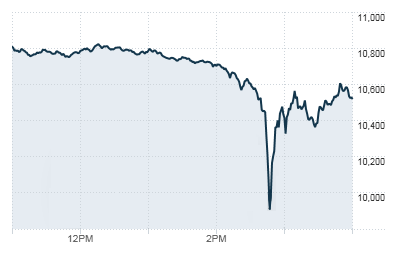Flash Crash (instant collapse) is a sharp drop in prices in the stock, currency or futures market, which can be tens of percent.
In most cases, after the collapse caused by the Flash Crash, the price quickly recovers.
The appearance of a flash crash, which resulted in a sharp collapse in the price, usually causes confusion among most traders.
Investors do not understand what happened to the price, and what is the reason for such a sharp change in the rate.
What causes Flash Crash?
Содержание статьи:
Human Error – The US Securities and Exchange Commission (SEC) has cited humans as the main cause of periodic crashes in the stock and other markets.
When traders or investment fund managers create huge volume market orders, they are the ones who are blamed for the Flash Crash.
Computer/Software Issues – Due to technical glitches, stock quotes can sometimes fluctuate.
Errors in the program code of trading advisors can also have negative consequences, provided that trading is carried out using large amounts of money.
Outright Fraud – A practice known as “Spoofing” involves placing a large number of large sell orders on the market.
The U.S. Commodity and Futures Trading Commission (CFTC) believes that this method was only responsible for the sudden collapse of the S&P 500 in 2010.
High Frequency Trading (HFT) – HFT is a controversial trading method in which an automated system driven by algorithms is used to recognize changing market conditions in order to execute trades accordingly.
HFT systems can place a large number of sell orders in the market at lightning speed , thereby causing a negative price movement.
Although the role of HFT companies is controversial, central banks such as the Bundesbank in Germany believe that it is HFT companies that increase the risk of Flash Crash.
Examples of major crashes in financial markets
The sudden collapse of the NYSE 2010
The Flash Crash NYSE led to a sudden crash in the US stock market on May 6, 2010, causing the Dow Jones to fall 1,000 points in just 10 minutes before recovering again.
At the same time, many stocks on the New York Stock Exchange (NYSE) fell to $1 or less. It was this event that led to the fact that gold rose to a record high of $ 1,200 per ounce.
According to the police investigation, the Englishman Navinder Sarao became the culprit of the collapse. Investigators found that Sarao listed and then canceled hundreds of “E-mini S&P” futures contracts.
He used illegal sales tactics that forced Waddell & Reed to cancel a $4.1 billion contract.
CME Group has warned Sarao and his broker MF Global that such deals are an attempt to manipulate the market by creating an excess supply of assets.
During this event, most investors assumed that the reason for the next Flash Crash lies in the high probability of a Greek default, which will lead to irreversible consequences throughout the European Union.
Flash Crash Bondov 2014
On October 15, 2014, the 10-year Treasury yield fell from 2.0% to 1.873% in a matter of minutes and then quickly recovered.
What was the biggest collapse since 2009. Many blame algorithmic bots for the collapse, as 60% of transactions are made electronically, not over the phone.
The event rendered the computer system nearly incapable of responding to large blocks of transactions leading to the Flash Crash.
The sudden collapse of the NASDAQ
The NASDAQ is notorious for its sudden crash. On August 22, 2013, the NASDAQ closed from 12:14 pm to 3:25 pm EST.
One of the NYSE servers was unable to contact the NASDAQ server to provide stock price data. Despite many efforts, the problem could not be resolved and the NASDAQ server went down.
It was this NASDAQ mistake that led to losses of up to $500 million when Facebook’s first IPO was announced. On May 18, 2012, the IPO was delayed by 30 minutes.
For this reason, traders could not open orders. After the glitch was fixed, 460 million shares were successfully sold.
How does Flash Crash affect the financial markets?
The main danger is that the emergence of Flash Crash could lead to a recession. However, most investors believe that Flash Crash is just a technical glitch and not a loss of market confidence.
But if the Flash Crash lasts long enough, its consequences can have a significant impact on the market situation, and many of the bidders will prefer to transfer funds to other assets.

